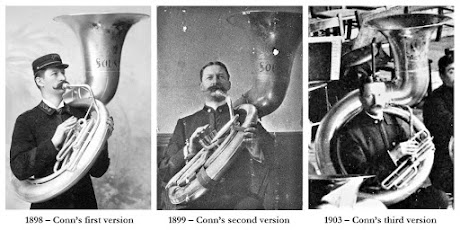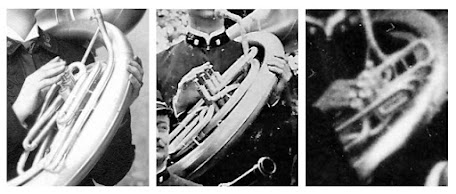The announcement makes it sound like Conn both created and named this new instrument, which suggests that either the reporter wasn't aware that Pepper had already done that, or that the journal just printed what Conn had supplied, which was perhaps a tad misleading! (Both Pepper and Conn were known to stretch the truth in some of their advertising back in those days.)
But Pepper's Sousaphone did indeed exist, and even went on tour with Sousa's Band in 1896. But then it seems to disappear. The next time we see a Sousaphone in that great band, it's Conn's first one, which was most likely built in late 1897.
From the notice above, we can safely assume that Conn's new horn was silver-plated. But what did it look like? Below is a visual history of this important instrument, which reveals that it evolved through at least three slightly different versions.
1898 - Conn's first version
Once his Sousaphone was built, and Herman Conrad, the "Primo Basso" of Sousa's Band, was available for a photo session, this wonderful image was created:
The instrument has four valves (Pepper's Sousaphone only has three), although the tubing is rather odd, going in different angles, and with a good bit of it buried where we can't see it. Further, notice that the lead pipe extends over from the top of the second branch of the main coil of the body. And it looks like the neck is custom-fitted for Conrad, as no tuning bits are evident.
The engraving at the bass of the bell shows the capital letters "S O U S," with an "A" almost certainly around the curve. And then there is a more elaborate engraving above that, the details of which are virtually impossible to make out. But it must have looked spectacular!
Here's the earliest known photo of this instrument in the context of the band, which was taken in St. Louis in September of 1898:
1899 - Conn's second version
Almost exactly a year after the above photo was taken, an illustration of Conn's Sousaphone appeared in The Pittsburgh Post (Sept. 17, 1899), and the valve cluster is significantly different:
Now the fourth valve tubing is in the open, extending out with a larger loop, and laying over the middle of the second branch. And the lead pipe emerges not from the top of the second branch, as in version one, but from within what I assume is the top loop of the main tuning slide.1903 - Conn's third version
But Conn still wasn't done tinkering with his Sousaphone. For while we don't know exactly when version three was created, our first glimpse of it comes in this photograph when Sousa's Band was performing in London in early 1903:
Before examining the new layout of the valve cluster, it's worth noting the bell engravings - to the extent we can make anything out! Is it the same bell as in versions one and two? I'm not sure, although it seems possible to detect, however faintly, where the "S O U S A" might be on the lower part of the bell. But perhaps I'm imaging things!
Regardless, the third valve tubing now runs the length of the valve cluster, with the longest part positioned below the fourth valve - something we hadn't seen before. And the lead pipe appears a bit lower, more in line with the valves, and, based on later photos, apparently curls up and around the upper part of the main tuning slide tube, rather than right through the middle of that upper loop, as it did in version two.
This is the version that we see Jack Richardson playing with Sousa, after he replaced Conrad, who left the band in August 1903. Here's the earliest known image of Richardson with Sousa, at Willow Grove Park in 1905:
Again, just to be clear, here are all three versions of the valve clusters side-by-side. They are clearly different:
And here's a better look at version three from the Conn Sousaphone that is in the Greenleaf Collection at the Interlochen Center for the Arts, whose serial number (88983) suggests that it was built in 1905 - just a few years after Conn's third and final version appeared (and yes, that's me!):















Dave,
ReplyDeletePlease keep up the good work with your sousaphone chronicles!’
Steve Marcus
Conn 48K